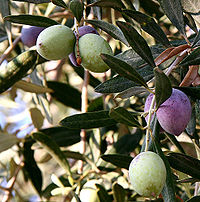
Photo from wikipedia
(1) Many studies demonstrated that olive oil and the leaves have several biological activities, but the works on olive twigs remain very limited. In this report, we investigated for anti-coxsackievirus… Click to show full abstract
(1) Many studies demonstrated that olive oil and the leaves have several biological activities, but the works on olive twigs remain very limited. In this report, we investigated for anti-coxsackievirus B-3 (CVB-3) and anti-herpes virus type 2 (HSV-2) activities of olive twigs from two Tunisian varieties: Chemlali (CM) and Chétoui (CT). Extraction from the olive twigs was carried out using successively hexane, dichloromethane, ethyl acetate and methanol. The obtained extracts were evaluated for their anti-CVB-3 and anti-HSV-2 activities by MTT and plaque reduction assays, respectively. Only hexane extracts exhibited significant activity with a selectivity index of 6.32±0.67 and 5.24±0.82 for CM and CT, respectively. The active compound was isolated through bio-guided assays using Thin Layer Chromatography (TLC) and identified as 2,4-di-tert-butylphenol (2,4-DTBP) by gas chromatography coupled with mass spectrometry (GC-MS). This work is the first study that demonstrated an antiviral activity of both olive twigs and DTBP.
Journal Title: Microbial pathogenesis
Year Published: 2019
Link to full text (if available)
Share on Social Media: Sign Up to like & get
recommendations!